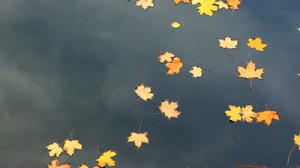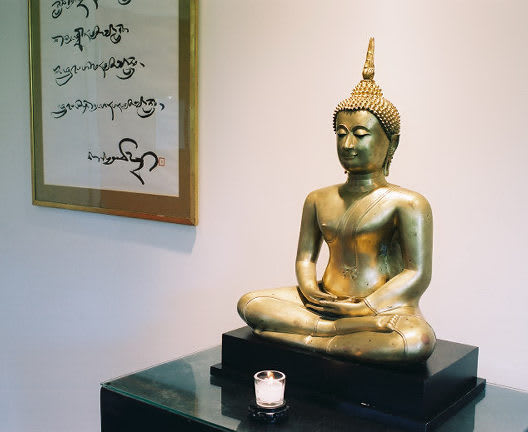Reflections about Aging in Shambhala
 COLUMN: Aging in Enlightened Society
COLUMN: Aging in Enlightened Society
by Ann Cason
NB: “reprinted” from the Shambhala Times.
Cyrus Crane was a community member, an early student of Chogyam Trungpa Rinpoche. He was already 69 years old when he started practicing meditation. Back in the late 1970’s, after an early Shambhala Training retreat, he asked, “Well, how am I supposed to synchronize my body and mind. My body is falling apart?”
“Just go with it,” a friend suggested. This sounds similar to the metaphor that Trungpa Rinpoche used in his book, Smile at Fear. He gave the image of an autumn leaf that falls into the river, and goes with the energy of the river. “It doesn’t change its color, and it doesn’t struggle with the river.” I like this way of looking at it.
According to Cynthia Spencer of the Shambhala Working Group on Aging, “The Shambhala view on aging and death is that it is an integral part of life.” As Shambhalians we can approach getting old and dying with confidence.
We don’t try to welcome it or deny it. As human beings, we hold views about aging and dying that are part of our inheritance from family, religion or school. My mother always told me that there is “more than one way to skin a cat.” Now that I am Buddhist, that saying sounds inappropriate. But it still slips out once in a while. As a Shambhalian, I can appreciate the idiom of my background as I bring my practice to it. In any case, Shambhalians don’t usually insist on concepts of the right way to age or to die. But we notice what works.
 As well, we study the teachings of the enlightened masters. In addition to all of our regular practices of sitting, Lojong and advanced Shambhala and Vajrayana practices, we might just relax with being old. We might also find what practices are recommended for aging and dying. What kinds of supports are needed to learn and do the practices? Sometimes bringing in the arts as well as the art of healing uplifts and communicates what can’t always be described in words.
As well, we study the teachings of the enlightened masters. In addition to all of our regular practices of sitting, Lojong and advanced Shambhala and Vajrayana practices, we might just relax with being old. We might also find what practices are recommended for aging and dying. What kinds of supports are needed to learn and do the practices? Sometimes bringing in the arts as well as the art of healing uplifts and communicates what can’t always be described in words.
In particular, our view is that aging starts at birth. So as practitioners of Shambhala, we might practice the Birthday Sadhana every year on our birthday or on Shambhala Day. It is a practice which encourages bringing our body, speech and mind to our lives. It encourages us to stay in touch with impermanence; to celebrate the passing of time instead of ignoring it. Also there are the Passages programs that we are starting to do. Every ten years we are taught to let go of the old and embrace nowness. We do this at ages twenty, thirty, forty, fifty, sixty, seventy, eighty, ninety and so on. Every year we celebrate the changing of the seasons. Shambhala is moving along in the creation of enlightened society and working on what Sakyong Mipham calls a culture of kindness.
Here at the Portland Shambhala Center, we have a “Conversations on Aging” workshop four times a year. We have talked about aging as suffering, aging as empowerment, aging as caregiving (either giving it or receiving). But what is most moving is to sit in a circle and share our very specific situations with each other. It is very healing to listen and to speak.
Last week we heard from a man who is aging well and gradually starting to need a cane from trouble with his joints; a man whose life is challenged yet opened by caring for his wife who suffers from Alzheimer’s; a man pouring his heart into the care of his mother who is in assisted living – he wonders if he should bring her to his home for her dying or should he get a cot and stay there by her side? And then there is the man, so courageous, who fears dying so much it interferes with his life; yet he comes to this workshop. One man shared articles from the New Yorker and Sun magazines as well as how it was for him when his mother died. And we heard from a woman who turned 60 and started thinking how it was when her mother died.
There was awareness of last month’s article in the Shambhala Times by David Whitehorn entitled “Funding Elders.” Some of us will have sufficient funds; others won’t. Some will age with their own children, some will die in the home of a sangha friend who offers shelter, some will live in assisted living, some will be able to stay in their own homes, some of us will be on public support and try to bring dignity into places that have never seen it before.
Hopefully one day our community will have retirement housing and financial assistance where needed.
Nevertheless, we each have our own situations. Like Cyrus Crane who came to the sangha with little money or family. He practiced for years often sitting at the back of the meditation hall with his hearing aids squealing and beeping not unlike the sounds of social media today.
One day I saw him in the bookstore in Boulder. He was taking down a copy of The Tibetan Book of the Dead. “Rinpoche tells me that I am going to die soon,” he told me. And sure enough before the year was out, Cyrus gave a big party for his 80th birthday. It was held at Shambhala Training with dancing, toasts and good food. The next day Cyrus checked into the hospital and died the next day after that.
May we all be like autumn leaves in the river…
To read more articles in this Column, please click here.
 ~~
~~
Ann Cason is a pioneer in bringing the principles of mindfulness, compassion, and respect into the care of elderly people. Her book, Circles of Care (Shambhala Publications) is an innovative exploration of the issues involved in working with old age. Her insights come from many years of professional and personal experience. She is a geriatric care manager based in Portland, Oregon and is a member of the Shambhala Working Group on Aging.







